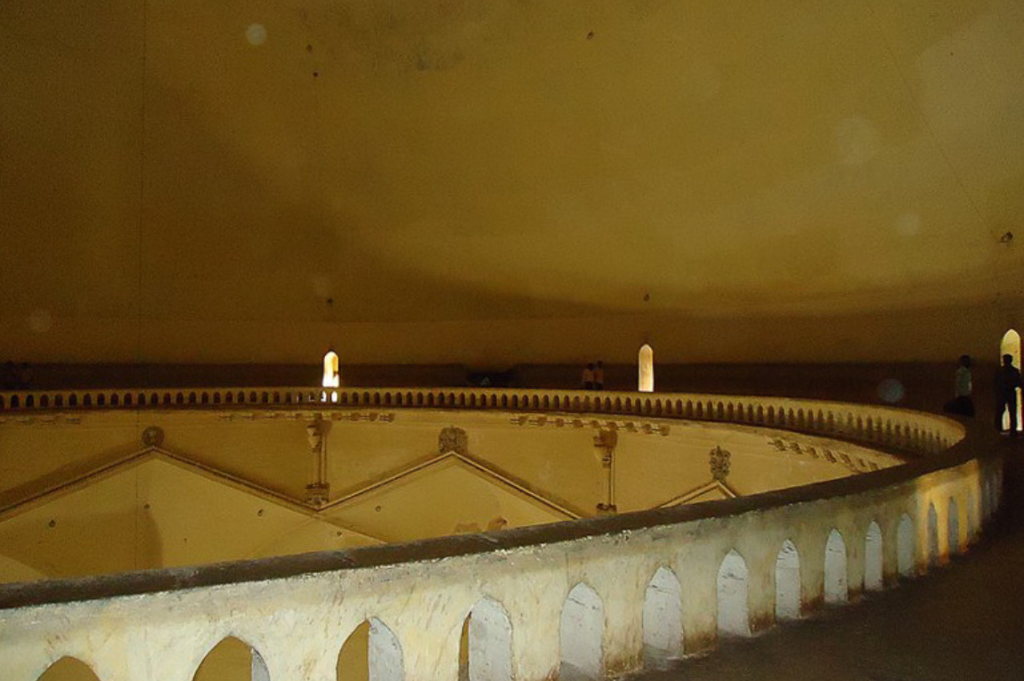My visit to the north Karnataka city of Bijapur (officially called Vijayapura) in the summer of 2014 was a revelation. The idiosyncratic architectural splendour of the Indo-Islamic medieval city built by the Bahmani Adil Shah dynasts — who ruled from the late 15th to the late 17th century — was not just abundant and unique but also strangely beguiling. With direct influences from Persia and Central Asia, Bijapur’s structures are quite distinct from northern Mughal styles. This distinction is seen by some as the peak of Indo-Persian architecture in India. The surface decorations of Ibrahim Adil Shah II’s mausoleum complex at Ibrahim Rauza, the ruins of Sangeet Mahal at Nauraspur and the rectangular Asar Mahal are some of the visual treats of this fantasy city of the past, which seem apt for the staging of a cinematic epic of grand proportions.
It was, however, the Gol Gumbaz, a massive mausoleum, that offered delights beyond mere spectacle. Built during the final years of Sultan Muhammad Adil Shah who died in 1656 CE, the majestic structure is a special destination for those interested in both architecture and sonic phenomena. This is on account of the interior acoustics. The great main hall is a richly reverberant chamber, covered by an enormous dome which is supported by cross arches and pendentives, or triangular segments often seen in church architecture. On the inside, the dome is 135 feet in diameter, with its topmost point 178 feet from the ground. In the centre of this hall are cenotaphs — beneath which are housed the tombs in an underground cellar. The exterior has many interesting features such as the imposing hexagonal towers, the cornice running around the structure and the entrance adorned with a bijli pathar (meteoric stone). The famous physicist CV Raman hailed the “daring spirit of the architect” of the Gol Gumbaz, describing its “virility of conception” in contrast with the “femininity” of the Ibrahim Rauza, which is located not too far away.
However, what fascinated me the most was the gallery inside that runs around the dome and is nearly 110 feet high. It is one of the rare ‘whispering galleries’ of the world. In India, a few other structures studied by Raman, such as the Victoria Memorial in Kolkata and the Bankipore Golghar Granary in Patna, are sonically similar, but are no comparison to the scale and acoustics of the Gol Gumbaz. A faint sound can be heard directly across opposite sides at a distance of 124 feet. A single clap is distinctly echoed 12 to 14 times. As the colonial architect SS Rueben stated in a monograph titled The Architecture of Bijapur, the Gol Gumbaz “is one of the finest structural triumphs of Indian builders.” The colourful prose of the Scottish archaeologist and photographer Henry Cousens in his book Bijapur: The Old Capital of the Adil Shahi Kings (1889) best describes the many sounds of this architectural marvel:
“On entering the building one is struck with the loud echoes that fill the place in answer to his footfall; but these sounds are much intensified on entering the gallery. One pair of feet is enough to awaken the echoes of the tread of a regiment; strange eerie sounds, mocking whispers, and uncanny noises emanate from the walls around. Loud laughter is answered by a score of fiends. The slightest whisper is heard from side to side; and a conversation can be most easily carried on across the full diameter of the dome in the lowest undertone.”

The relationship between space and sound is a fascinating one. A space shapes the sound within it; the texture, tone, timbre and time of a sound are defined by the space it exists in. The sound of footfalls at an airport, for instance, is completely different from those in an office or on a beach. Buildings such as the Gol Gumbaz, and others of antiquity like temples, ziggurats, tombs and palaces of the past, “must have held special connotations”, the Australian writer Peter Doyle says in his book Echo and Reverb: Fabricating Space in Popular Music Recording, 1900–1960, given how sound is amplified and texturised within them. Just as materials like metal, wood or stone develop a patina over time, such old buildings perhaps acquire an ‘aural patina’ (a term used by Kavichandran Alexander, audio engineer and founder of the American record label Water Lily Acoustics, in several discussions with me).
Visitors, especially children, truly enjoy the sonic aspect when they visit the Gol Gumbaz. Through their claps, shouts, cries, whistles and whispers, tourists engage with the structure in a carnivalesque way. Here, they learn to appreciate and find delight not just in the visual splendour the structure offers but its sound, too. This, to me, holds great meaning, given the absence of such sonic structures in modern and contemporary architecture the world over.
Find your way to the Gol Gumbaz in Bijapur, Karnataka via Google Maps here.
Our selection of stays across India, best visited for their design and style. Check in
Gautam Pemmaraju is a Mumbai-based writer, researcher and filmmaker working in the areas of history, literature and art. He is on Instagram at @gautam.pemmaraju.







